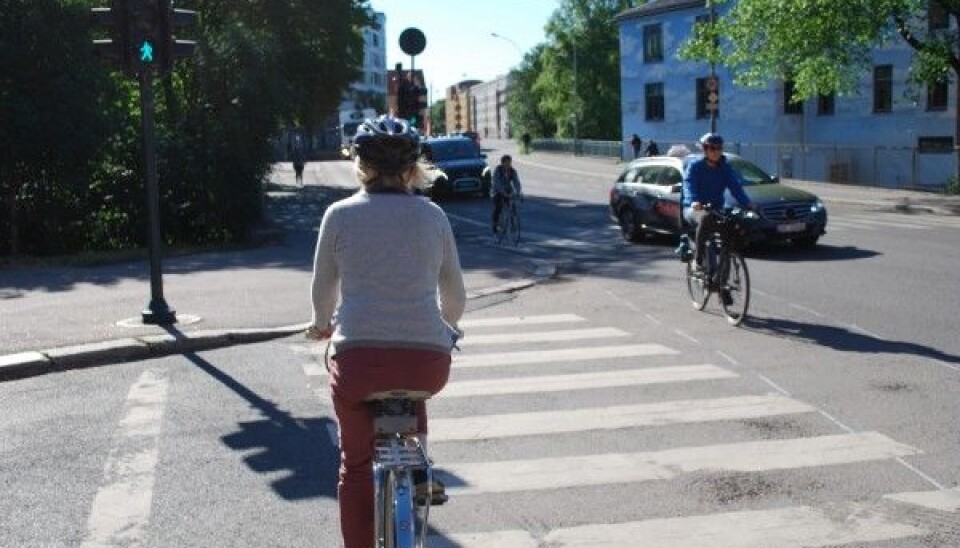
Should bicycle helmets be mandatory?
New research shows that cyclists reduce their risk of head injuries by 60 percent when they wear helmets, but experts wrangle on the question of making them mandatory by law.
Over half of all Norwegians who ride bicycles do not use helmets, according to figures from the Norwegian Council for Road Safety.
A new study shows that helmets reduce the risk of serious head trauma by 60 percent. Turned around, that means you run nearly twice the risk of serious head injury in an accident if you are not wearing a helmet. Head injuries are the most common fatal injuries among bicyclists in road accidents.
Moreover, helmets reduce the risk of serious brain damage and face injuries. The total number of killed or seriously injured cyclists drops by 34 percent when they have these protective shells around their skulls.
Best when no vehicles are involved
Bike helmets have the greatest effect in accidents in single-bicycle accidents than when the bike rider crashes with a motor vehicle.
Single-bike accidents occur in lots of ways: For example when you skid on slippery roads, brake too hard and take a tumble, do a front flip when a shopping bag swinging from your handlebars snags in your spokes, not to mention all the other lessons you can learn about the laws of motion while trying to avoid crashing into a garbage bin or a telephone pole.
None of the above is pleasant, but getting hit by a car, bus or truck can very easily be worse.
The new study was recently published in the journal Accident Analysis and Prevention.
Here, Alena Høye of the Norwegian Centre for Transport Research (TØI) published the results of a meta-analysis covering 55 studies about the relationship between use of bike helmets and head injuries, whether they be from single-bike accidents or collisions with motor vehicles.
Better protection for children?
Most kids in Norway, 87 percent, use helmets when riding their bikes according to a study from 2015. In 2006 the corresponding share had been 63 percent. In the same period, helmet usage among adults rose from 32 percent to 56 percent.
The new study shows that the protective effect of bicycle helmets is the same for children and adults.
“We might have thought that helmets have a greater protective effect on adults because they cycle faster or because their spills are from higher up,” she says.
“On the other hand, children cycle less in traffic and we could expect them to have a higher proportion of single-bicycle accidents, where helmets have a greater effect.”
But the results show no differences in this respect; bike helmets are equally important for adults and children.”
Making it the law
Many countries have laws requiring the use of bicycle helmets, including Australia, New Zealand and Argentina. It is mandatory in Sweden too, but only for children.
Norway has no such helmet law – at least not yet.
The issue has been debated back and forth in Norway. Earlier research showed that the use of helmets did not lead to fewer accidents.
“Of course we cannot expect helmets to reduce accidents,” says Høye.
This is because even though cyclists who wear helmets on average have fewer and less serious accidents than those who don’t, their numbers are skewed on the side of caution – according to Høye they tend to be generally more safety conscious.
They also are more likely to have ample lights on their bikes, use reflectors and ride less often on sidewalks. Pedestrian pavements are statistically riskier for cyclists than streets or bike lanes.
“With a mandatory helmet law we could expect to reduce head injuries among cyclists,” says the researcher.
Fearing it is counterproductive
Researchers and avid cyclists have piped in with disparate arguments when the mandatory use of helmets has been debated in Norway. Their experiences and positions vary. Several arguments have been made against a helmet law:
“Cyclists often tend to compensate for the effect of a helmet by feeling more confident and riding faster. This can counteract and lessen the injury-reducing effect,” said researcher Aslak Fyhri in an article published by ScienceNordic’s Norwegian partner forskning.no. He works at TØI’s section for safety and the environment.
Another argument is that some people would quit riding bikes if forced to wear helmets.
According to Fyhri, the cyclists who would quit pedalling in this instance also tend to be in the category of cautious types, persons who less frequently get in accidents. In this case, a mandatory helmet law could actually raise the general risk of accidents because a larger share of those still on bikes would be the aggressive and risk-taking types.
Ambiguous research
“The issue of whether a law would impact the number who use bicycles is uncertain,” asserts Alena Høye.
“Some studies have indicated that the number of cyclists would dip but that this decrease is usually relatively short-lasting. The biggest drop would actually be amongst the cyclists who use their bikes the least, so this negative impact on cycling and health and safety would be limited.”
Høye says that other factors entirely often have an impact on decisions whether to use bikes as a means of transportation.
“Substandard and unsafe cycling infrastructure, or the lack of it altogether, is higher up on the list. Other things too, like the availability of showers at the work place have shown themselves to be more important than helmet laws,” she says.
-------------------------------------
Read the Norwegian version of this article at forskning.no.
Translated by: Glenn Ostling
































